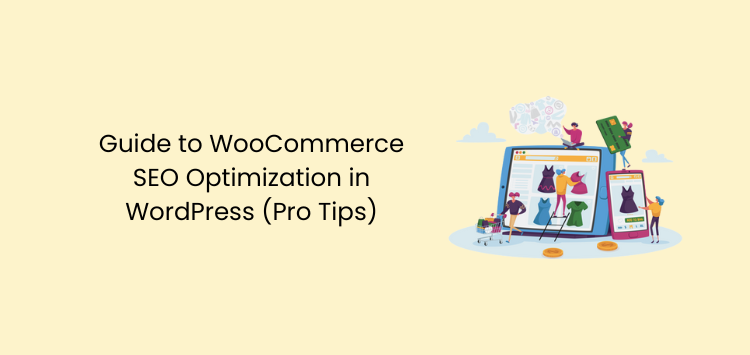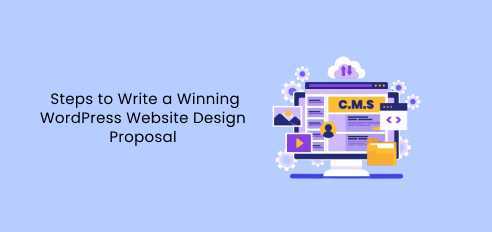Having a website without search engine optimization (SEO) is like trying to socialize in a bustling city without leaving your house. And when you have a Woo store, trying to sell without doing WooCommerce SEO optimization is like trying to get customers from the Sahara desert.
In simple words, no business can thrive and grow without implementing search engine optimization (SEO). And it is incredibly important for eCommerce businesses as well.
In this article, we will discuss what WooCommerce SEO optimization is and share the best tips for same.
Let’s get started.
What is WooCommerce SEO Optimization?
Search Engine Optimization (SEO) is the practice of improving a website’s visibility and ranking on search engines. It involves optimizing various aspects of a website so that it appears higher in search engine results when people search for relevant keywords.
WooCommerce SEO specifically refers to the process of optimizing an online store built with WooCommerce for better SEO rankings. It focuses on improving the visibility and ranking of product pages, category pages, and other eCommerce-related content on search engines.
When it comes to WooCommerce SEO, there are several important factors for you to consider. One of them is keyword research, which involves identifying the specific words and phrases that potential customers might use when searching for products.
By strategically incorporating these keywords into product titles, descriptions, and URLs, you can increase the chances of your online store appearing in relevant search results.
12 Best Tips for WooCommerce SEO Optimization
By now, you know that WooCommerce SEO optimization means optimizing different elements of your site to make sure search engine notices your products and list them high on the SERP (Search engine result pages). As a result, this can bring free traffic (visitors) to your store and also grow your reputation as a brand.
Here are some effective tips for WooCommerce SEO optimization.
Optimize Product and Category Page Titles
Your product titles tell your customers and search engines what your page/product is about. And your category page title tells them about the type of the products.
For example, you are selling Nike shoes and sneakers. One of your product’s name is Nike Dunk Low. So, your category page name can be Nike Shoes & Sneakers, and the product title can be Nike Dunk Low.
To optimize product and category page titles for WooCommerce SEO, here are some tips:
- Use relevant keywords that describe your products or categories naturally.
- Keep the titles concise and descriptive, avoiding keyword stuffing or making them too long.
- Include important information like product attributes or unique selling points to help customers quickly identify relevant products.
- Place your primary keyword at the beginning of the title to give it more weight in search engine rankings.
- Customize category page titles to be specific and compelling, avoiding generic titles.
- Consider including your brand name in the titles to establish brand recognition.
- Test different variations of titles and analyze their performance using tools like Google Analytics or WooCommerce analytics plugins.
Remember to focus on providing high-quality, relevant content on your product and category pages while optimizing WooCommerce category SEO and product title SEO.
Utilize Meta Descriptions
Meta descriptions are significantly important for WooCommerce SEO optimization. It is the short description you see in search results.
To optimize meta descriptions for WooCommerce SEO, consider these tips:
- Write concise and engaging summaries that accurately describe your product or category pages.
- Include relevant keywords naturally to help search engines understand your page’s context.
- Keep meta descriptions within the recommended length of around 150-160 characters.
- Highlight unique selling points to entice users to click on your page.
- Craft descriptions that appeal to users, not just search engines.
- Avoid using duplicate meta descriptions for multiple pages.
Optimize Product URL
The product URL is the link to your WooCommerce product pages. You can set a fixed format for the URLs from WordPress permalink settings, or you can edit individual product URLs from the slug settings of SEO plugins.
To WooCommerce SEO optimize product URLs, consider these tips:
- Keep URLs simple and descriptive, reflecting the product content.
- Include relevant keywords naturally in the URL.
- Use hyphens to separate words in the URL.
- Remove unnecessary words (stop words) to keep URLs concise.
- Configure static URLs instead of dynamic ones.
- Incorporate category hierarchy if applicable.
- Avoid duplicate URLs to prevent confusion.
- Test and fix any broken or incorrect URLs.
Use Categories and Tags
Using categories and tags effectively is important for WooCommerce SEO optimization. Here are some tips to optimize their usage:
- Create relevant categories to organize your products.
- Use clear and commonly searched category names.
- Assign multiple categories to products when relevant.
- Utilize hierarchical category structures for logical organization.
- Use tags for additional descriptors like attributes or keywords.
- Be consistent in assigning categories and tags.
- Avoid excessive or irrelevant categories and tags.
Create Unique Product Descriptions
Product pages need content if they are to achieve a high Google page rank. Your product descriptions should account for the vast majority of the text on a single product page.
The primary purpose of these descriptions is to inform and persuade shoppers to make a purchase. However, it is also important to include your target keyword and a few related keywords.
Follow these tips to optimize your product descriptions:
- Write original and compelling descriptions for each product.
- Provide detailed information about specifications, dimensions, and materials.
- Incorporate relevant keywords naturally into the descriptions.
- Highlight unique features and benefits of the product.
- Use formatting and bullet points for readability.
- Regularly update and refresh product descriptions.
Use Product Feed Marketing to Drive Customers and Improve SEO
This is a gem of an SEO and marketing strategy that only a few store owners are aware of.
A product feed is a structured file that contains all your WooCommerce product information. To put it simply, it is a spreadsheet file that contains your product data, such as title, description, category, tags, prices, brand, availability, link to product and images, etc.
You can use these files to connect your WooCommerce store to multiple channels and list and promote your products on those platforms. You can display your products on price comparison engines, marketplaces, and social media platforms and also run shopping ads on shopping engines.
For example, you can create product feed files and upload them on marketplaces like Amazon, Walmart, eBay, Target, etc. You can also directly compete with your rivals by listing your products on price comparison engines such as Google Shopping, Bing smart shopping, Idealo, etc.
In addition to those platforms, social media platforms such as Facebook, Instagram, Snapchat, etc., requires a product feed to display your products.
By displaying and promoting your products on these platforms, you can reach millions of potential customers directly and increase your conversions. Moreover, some of these platforms let you promote your products for absolutely free.
If you have an SEO-optimized WooCommerce store, your product feed files will contain the same optimization data as well. As a result, you will have a greater chance to rank high on search engines.
You can create product feed files for hundreds of channels right from your WooCommerce admin panel. You can use a WooCommerce product feed plugin to create an unlimited product feed for unlimited products within a couple of clicks.
These plugins also let you connect to the marketplaces through URLs and update your WooCommerce data automatically.
Enable Breadcrumbs for Easy Navigation
Breadcrumbs are ways to find your way around a website. They show the page’s hierarchy. They usually show up near the top of a page and link back to previous pages or categories. This helps users figure out where they are on your website.
They aid WooCommerce SEO optimization by making your shop more easily crawlable and understandable by search engines like Google. Google also displays breadcrumbs in search results, which is great for boosting your online shop’s visibility.
Ensure that your website has a well-organized structure with clear categories and subcategories. This helps establish a logical breadcrumb trail that users can follow.
Customize the breadcrumb display to show the appropriate levels of your website hierarchy. For example, if a user is viewing a product page, the breadcrumb might show the category, subcategory, and product name.
WooCommerce SEO image optimization
Optimizing images is crucial for SEO optimization WooCommerce. Follow these tips to optimize your images:
Optimize alt tags: Add descriptive alt tags to your images.
Alt tags provide alternative text that appears when an image fails to load or for accessibility purposes. Use relevant keywords and accurately describe the image content while keeping the text concise.
Use descriptive filenames: Give your image files meaningful names that describe the content. Instead of generic names like “IMG001.jpg,” use specific keywords related to the image, such as “handmade-leather-wallet.jpg.”
Compress images: A website’s user experience and search engine rankings can suffer if it takes too long to load images. Compress your images to reduce their file size without significant loss of quality. Several online tools and plugins are available for you to help with this.
Choose the right image format: Use the appropriate image format based on the content and purpose. JPEG is ideal for photographs, while PNG is suitable for graphics or images with transparency. Selecting the right format helps balance image quality and file size.
Add captions and context: If applicable, consider adding captions or surrounding text that provides relevant context to your images. This helps search engines understand the image’s purpose and can improve its relevance in search results.
Add Structured Data for Rich Snippets
Structured data uses specific markup formats, such as Schema.org, to provide additional information about your content to search engines. It helps search engines understand and display your content in more informative and visually appealing ways, such as rich snippets.
Here’s an example of an eCommerce-rich snippet.
In addition to other regular details, rich snippets allow you to display helpful information such as price, ratings, number of reviews, stock status, etc., in the search results.
Use a WooCommerce SEO Plugin
Plugins such as Yoast, RankMath, etc., can make your WooCommerce SEO optimization a breeze and help you rank higher on search engines with minimum effort.
A WooCommerce SEO plugin can help optimize your store in several ways:
Metadata optimization: These plugins allow you to easily customize and optimize meta titles, descriptions, and URLs for your product and category pages.
This helps improve the visibility and click-through rates of your pages in search engine results.
XML sitemap generation: A good SEO plugin will automatically generate XML sitemaps for your WooCommerce store. These sitemaps make it easier for search engines to find and index your pages, making them easier to find in search results.
Schema markup integration: A WooCommerce SEO plugin like Yoast comes with schema markup integration. It simplifies the process of adding schema markup to your product pages, enhancing their appearance and attracting more clicks.
On-page analysis and recommendations: SEO plugins often offer analysis tools that evaluate various on-page elements, including keyword usage, content optimization, internal linking, and image attributes. Based on the analysis, the plugin provides recommendations and suggestions to improve these elements for better SEO performance.
Optimize Site’s Speed and Performance
Optimizing your site’s speed and performance is crucial for WooCommerce SEO.
To optimize your WooCommerce site’s speed and performance:
- Choose a reliable hosting provider.
- Enable caching to store static versions of your content.
- Optimize images by compressing them.
- Minify CSS and JavaScript files to reduce their size.
- Limit the number of plugins and scripts.
- Use a content delivery network (CDN) to deliver content faster.
- Optimize your WooCommerce database regularly.
- Monitor and fix broken links.
- Test and monitor your site’s performance.
Maximize Site’s Security
WooCommerce site security is important because it protects your customer data, maintains your brand reputation, prevents your financial loss, improves SEO rankings, mitigates disruptions, and ensures compliance with regulations.
To maximize your WooCommerce site’s security:
- Keep all your plugins up to date.
- Use strong and unique passwords.
- Enable HTTPS/SSL encryption.
- Implement a web application firewall (WAF).
- Regularly back up your site.
- Choose a secure hosting provider.
- Install security plugins designed for WooCommerce.
- Secure user roles and permissions.
- Monitor for suspicious activity.
Wrap up
In conclusion, you need to optimize your WooCommerce store for SEO if you want to get more organic traffic, be more visible, and make more sales.
By following the WooCommerce SEO optimization pro tips outlined in this guide, you can elevate your store’s SEO performance and achieve greater success in the competitive online marketplace.









